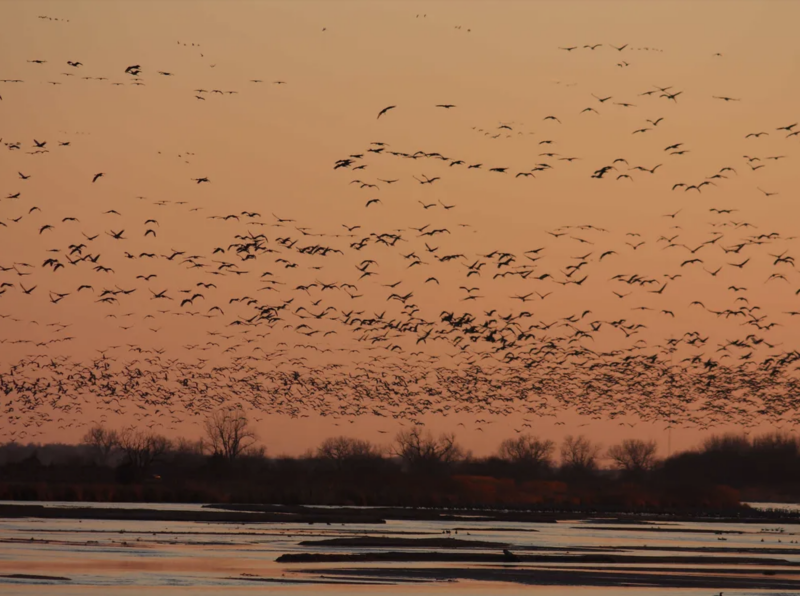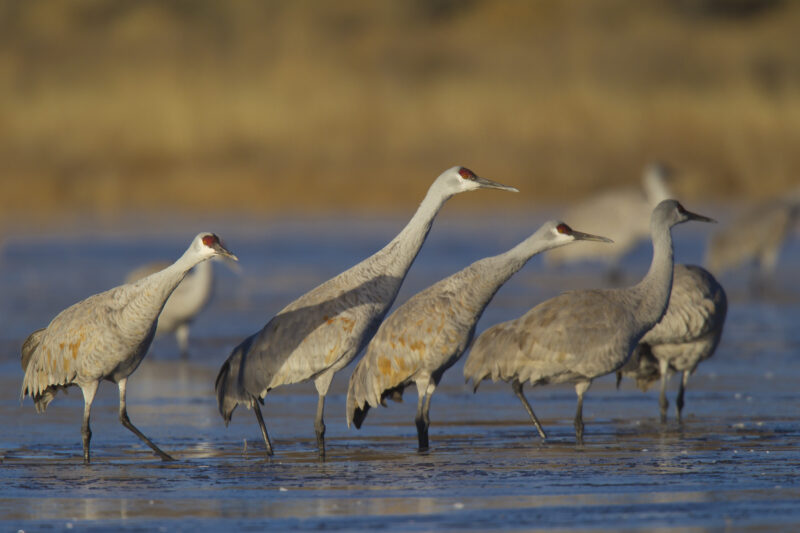
Sandhill cranes are showing up in Nebraska in staggering numbers in 2024. Bethany Ostrom, a wildlife biologist, reported on February 24, 2024, that the annual Crane Trust bird count census was revealing about five times the average population. The excited scientist wrote at a Crane Trust blog:
Another record week! On February 24, 2024, we estimated 122,700 + 9,100 sandhill cranes between Chapman and Overton, Nebraska … On average, this time of year [week 2 of the annual count], we see around 27,000 cranes.
Ostrom had begun writing about the big boost in Sandhill crane numbers earlier in February. On February 14, she’d reported finding more cranes at the start of the annual bird than the excited scientist had ever seen:
On February 14, 2024, we estimated 38,000 ± 6,800 sandhill cranes between Chapman and Overton, Nebraska. This is the highest count on record during the first week of our aerial surveys.
The yearly bird-count – begun in 1998 – is conducted on an 80-mile (130 km) stretch of the Platte River. The U.S. Fish and Wildlife Service, which has conducted its own annual crane surveys in the Central Platte River Valley since 1979, estimates an average of more than 500,000 of the birds turn up each spring between February and April.
The professional birdwatchers also spotted a host of other transient avians around Valentine’s Day this year:
We also estimated around 2,000 dark geese, 19 trumpeter swans and 18 bald eagles. Our dark geese estimate was very low compared to past years. (Dark geese include canada, brant and other goose species.) Snow geese were very abundant in the area, but we do not include them in our estimates.
Want to see the cranes? The Crane Trust offers guided tours of sandhill crane nesting areas.
2024 lunar calendars on sale now. Makes a great gift! Check it out here.

Platte River is only a stop-over for cranes
Nebraska’s biggest river is the world’s most popular gathering spot for sandhill cranes (Grus canadensis). The enormous flocks of birds that turn up there each year are grouping up for a journey to the north when the weather grows warm enough. Smithsonian Magazine described the beginning of their annual odyssey:
Each spring, hundreds of thousands of the tall, long-legged birds begin making their journey north to breeding grounds in Alaska, Canada and eastern Siberia. Out of all the world’s sandhill cranes, 80 percent use Nebraska’s Platte River as a pit stop, where they fatten up on corn kernels left over from the previous fall’s harvest.
The Crane Trust’s Ostrom thinks early warm weather this year is behind the record crane counts:
Crane Trust research from 2019 suggests the probable cause of this year’s copious amount of early arrivals is the higher average winter temperatures. The winter of 2021-2022 was also a fairly mild winter and we had around 27,000 cranes on Valentine’s Day that year. An average first week count is around 6,000-8,000 cranes.
Large numbers of cranes this early in the migration could mean the population peaks early and moves on. Or maybe not, as the birds are not eager to migrate in less-than-ideal weather. In 2022, the number of cranes was impressively early, but the peak in population came late. The cranes apparently go whichever way the wind blows:
For example, in 2022 we had an impressive first count but we did not see peak numbers until March 21st because of cold fronts that came through the region. Cranes use the weather to their advantage, often riding the wake of winter, leaving spring behind them.
Sandhill cranes are part of an ancient lineage
Smithsonian Magazine says cranes have been hanging around the U.S. Midwest since before the country was even a twinkle in the Founding Fathers’ eyes:
Archaeologists at Ashfall Fossil Beds in northeast Nebraska unearthed the fossilized remains of a crowned crane – a close relative of the sandhill crane – that’s estimated to be roughly 10 million years old. The oldest sandhill crane fossil, found in the Macasphalt Shell Pit in Florida, is roughly 2.5 million years old.
Unfortunately, the wetlands that the sandhill cranes depend on are vanishing, the Crane Trust reports:
Wet meadows adjacent the Platte River provide important migratory, feeding, and nesting habitats for more than 150 species of birds and other wildlife in central Nebraska. Most wet meadows of the Platte River Valley have been drained and/or converted to cropland and other uses over the last several decades. As a result, wet meadows are now rare along the Platte River relative to their historical distribution.
Even more unfortunately, research published last year in Nature shows the loss of wetlands around the globe is part of a centuries-long trend:
We estimate that 3.4 million square kilometers (1.3 million square miles) of inland wetlands have been lost since 1700, primarily for conversion to croplands. This net loss of 21 percent of global wetland area is lower than that suggested previously by extrapolations of data disproportionately from high-loss regions. Wetland loss has been concentrated in Europe, the United States and China, and rapidly expanded during the mid-twentieth century.
The ongoing loss of migratory bird habitat is why the annual sandhill crane count is critical work:
These ongoing roost surveys are an important component of the Crane Trust’s monitoring program, enabling the trust and other conservation partners to better assess and understand the effects of different habitat management practices on cranes at this critical stage in their annual migration. The surveys continue into mid-April, when most cranes will have left the river to continue their migration to breeding grounds in the north.
Bottom line: Sandhill cranes are arriving in record numbers during their annual spring migration in the U.S. Midwest.
Read more: Bird migration forecasts get a boost from AI
Read more: 50 years of data show spring and fall bird migrations changing











